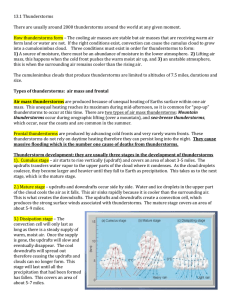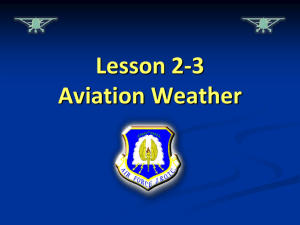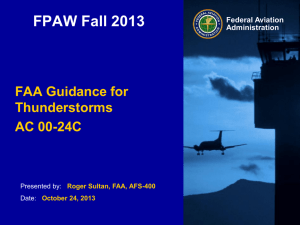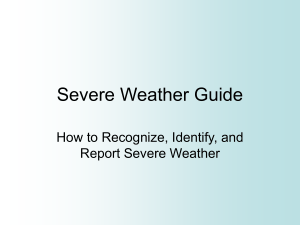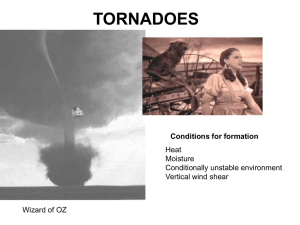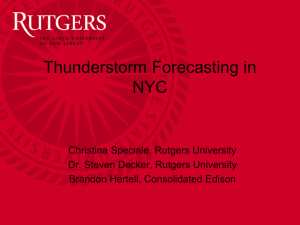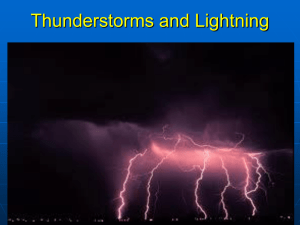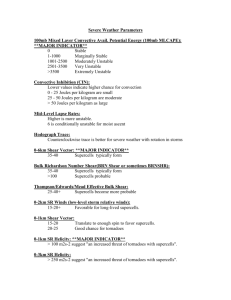The Nature of storms
advertisement
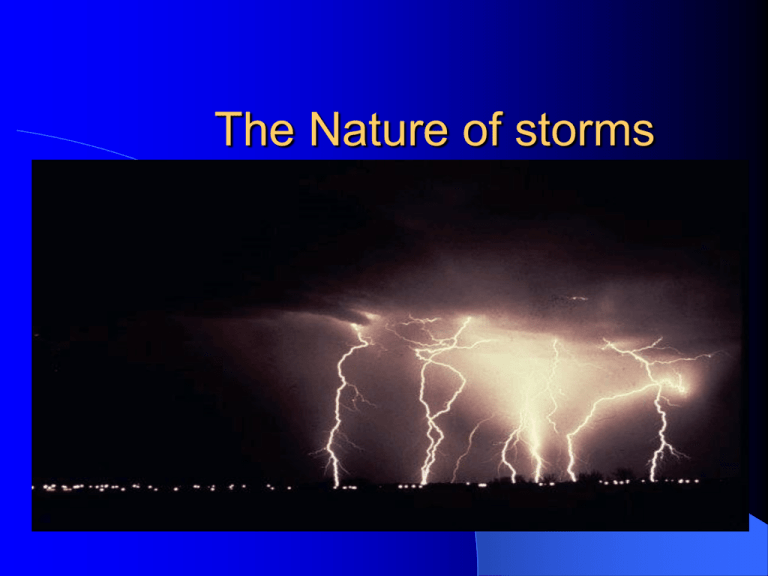
The Nature of storms I. Thunderstorms A. At any given moment, nearly 200 thunderstorms are occurring around the world. 1. Cumulonimbus clouds produce thunderstorms. 2. Three conditions must occur for a thunderstorm to occur. a. There must be an abundant source of moisture in the lower levels of the atmosphere. b. Some mechanisms must lift the air so that the moisture can condense and release latent heat. c. Portion of the atmosphere through which the cloud grows must be unstable. The air must continue to cool with increasing altitude for the growing cloud to stay warmer than the surrounding air. 3. If the three conditions just described are met the air will keep rising, causing more moisture to condense and creating more latent heat. 4. A typical thunderstorm lasts about 30 minutes. B. Air mass thunderstorms 1. Thunderstorms are often classified according to the mechanism that caused the air to rise. 2. If the air rose because of unequal heating of Earth 3. Surface within one air mass, the thunderstorm is called an air-mass thunderstorm. 4. The unequal heating of earth’s surface reaches its maximum during mid- afternoon. Thus air mass thunderstorms are most common then. 5. There are two common types of air-mass thunderstorms. 6. Mountain thunderstorms occur when an air mass raised as a result of orographic lifting. (Air moving up the side of a mountain) 7. Sea-breeze thunderstorms are common along coastal areas during the summer, especially in the tropics and subtropics. 8. Sea-breeze thunderstorms are local air-mass thunderstorms caused in part by the extreme temperature differences between the air over land and the air over water. C. Frontal Thunderstorms 1. The second main classification of thunderstorms is frontal thunderstorms, which are produced by advancing cold fronts and more rarely, warm fronts. 2. This rapid upward motion can produce a line of thunderstorms, sometimes very large. D. Stages of Development 1. A thunderstorm usually has three stages: the cumulus stage, the mature stage, and the dissipation stage. The stages are classified according to the direction in which the air is moving 2. Cumulus stage- air starts to rise nearly vertically upward. This creates updrafts, which transport moisture to the upper reaches of the cloud. This begins the mature stage of a thunderstorm. 3. Mature stagePrecipitation in a thunderstorm is composed of water droplets that formed at high, cool levels of the atmosphere. As the precipitation falls, it cools the air around it. This creates downdrafts. In the mature stage, nearly equal amounts of updrafts are downdrafts exist side by side in the cumulonimbus cloud. 4. Dissipation stage- the production of downdrafts is ultimately the thunderstorm’s undoing. The convection cell can exist only if there is a steady supply of warm, moist air at Earth’s surface. Once that supply runs out, the updrafts slow and eventually stop. II. Severe Weather A. Severe Thunderstorms 1. Other factors also play a role in causing some storms to be more severe than others. 2. The upper level usually accompanies cold fronts. Low-pressure system that are marked by pools of cold air 3. As the instability of the air increases, the strength of the storm’s updrafts and downdrafts intensifies. The storm is then considered to be severe. 4. They may develop into self-sustaining, extremely powerful storms called super cells, which are characterized by intense, rotating updrafts. 5. These furious storms can last for several hours. 6. Of the estimated 100,000 thunderstorms 10% are considered to be severe. B. Lightning 1. Lightning is electricity caused by the rapid rush of air in a cumulonimbus cloud. 2. A lightening bolt forms when friction between the updrafts and downdrafts within a cumulonimbus cloud separates electrons from some of their atoms either in the cloud or near the ground. 3. A lightning bolt heats the surrounding air to about 30 000 C. That is about five times hotter than the surface of the sun! 4. The thunder you hear is the sound produced as this super heated air rapidly expands and contracts. 5. Because sound travels more slowly than light waves, you may see lightning well before you hear thunder, even though they are generated at the same time. 6. Each year in the US, lightning accounts for about 7500 forest fires, which result in the loss of millions of acres of forest. 7. In the US lightning injures yearly 300 people and kills 93 people a year. C. The fury of Wind 1. Violent downdrafts that are concentrated in a local area are called downbursts. 2. Based on the size of the area they affect, downbursts are further classified as either macro bursts or micro bursts. D. Hail 1. Each year in the US almost $1 billion in damage is caused by hail. 2. Hail is precipitation in the form of balls or lumps of ice. 3. Hail forms because of two characteristics common to thunderstorms. 4. Water droplets exist in the liquid state in the parts of cumulonimbus cloud where the temperature is actually below freezing. 5. When these super cooled water droplets encounter ice pellets, they water droplets freeze on contract and cause the ice pellets to grow larger. 6. The second characteristic that allows hail to form is an abundance of strong updrafts so that they are constantly encountering more super cooled water droplets. E. Floods 1. Storms may dump its rain over a limited location rather than spreading it over a large area. 2. Floods occur. F. Tornadoes 1. A tornado is a violent, whirling column of air in contact with the ground. 2. Before it touches the ground it is called a funnel cloud. 3. Tornadoes are often associated with super cells, the most severe thunderstorm. 4. The air is a tornado is made visible by dust and debris drawn into the swirling column, or by the condensation of water vapor into a visible cloud. 5. Tornadoes can vary greatly in size and intensity. 6. They are classified according to the Fujita Tornado intensity scale it ranks tornadoes according to their path of destruction, wind speed and duration. 7. There are some locations that are more common for tornadoes to form. 8. Most tornadoes –especially the violent ones- form in the spring during the late afternoon and evening, when the temperatures contrasts between polar air, which still has winter characteristics and tropical air, which is steadily becoming warmer and the greatest. 9. More than 700 tornadoes touch down each year in the US. 10. Many of these occur in a region called “Tornado Alley” which extends from northern Texas through Oklahoma, Kansas and Missouri. 11. In the US, an average of 80 deaths and 1500 injuries result from tornadoes each year. 12. The National Weather Service issues tornado watches and warnings before a tornado actually strikes. 13. A watch means that the environment is favorable for a tornado. 14. A warning means a tornado has been spotted and touched down. III. Tropical Storms A. During summer and fall, the sunny tropics are birthing grounds for large, rotating, lowpressure storms called tropical cyclones. 1. The strongest of these cyclonic storms are known in the US and other parts of the Atlantic Ocean as hurricanes. 2. Cyclones thrive on the tremendous amount of energy in warm, tropical oceans. 3. Tropical cyclones require two basic conditions to form: an abundant supply of warm ocean water and some sort of disturbance to lift warm air and keep it rising. 4. Tropical cyclones move according to the wind currents and steer them. 5. A traveling tropical disturbance, which can cause air in a developing tropical cyclone to rise, is the first stage of a tropical cyclone. 1 6. Once winds reach speeds another phenomenon takes place- the development of a calm center of the storm called the eye. 7. The strongest winds in a hurricane usually concentrated in a band immediately surrounding the eye called the eyewall. 8. The Saffir Simpson hurricane scale classifies hurricanes according to wind speed, air pressure in the center and potential for property damage. 9. Category 1 hurricanes, which have a minimum, wind speed of 74mph, to the monstrous category 5 storms, which have winds in excess of 155mph. 10. A hurricane will last until it can no longer produce enough energy to sustain itself. This usually happens when the storm moves over land and no longer has access to the warm ocean surface from which it draws its energy, or when the storm moves over colder waters. 11. Hurricanes can cause a lot of damage, particularly along coastal areas where human populations have increased. 12. Most of the damage is associated with wind. 13. Strong winds moving onshore in coastal areas are partly responsible for another major hurricane threat: storm surges. 14. A storm surge occurs when hurricane force winds drive a mound of ocean water toward coastal areas, where it washes over the land. 15. The national hurricane center which is responsible for tracking and forecasting the intensity and motion of tropical cyclones in the western hemisphere, issues a hurricane warming at least 24 hours before it strikes. IV. Recurring Weather A. Floods and droughts 1. Droughts are extended periods of wellbelow normal rainfall 2. Thunderstorms can produce enough rain to produce floods. 3. An unpleasant side effect of droughts often comes in the form of heat waves, which are extended periods of above-normal temperatures. 4. Cold wave is an extended period of belownormal temperatures. 5. Wind transports heat away from the body, the effects of cold air is worsened by wind. 6. This phenomenon is known as a wind-chill factor. THE END

